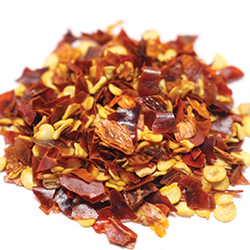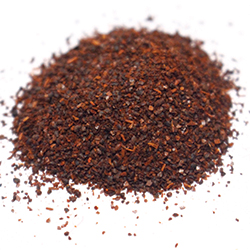When it comes to chili, the only constant is the rivalry over its varieties.
I’m standing over the stove, waxing nostalgic in the cumin-infused steam. Memories of late fall days, dad stirring the pot, the whole house warm under the spell of chili. Each year, when the air gets a chill—not the first one, but the lasting one that makes leaves crisp and toes tingle—it’s time. I set off to make the recipe he left behind.
Chili has a funny way of inciting emotion. Few foods are prone to such heated argument (save pizza crust or hot dog style), and the diehard camps—beans or no beans, red or green—are well suited to competition. Each chef lays claim to the “best” recipe, and the history of the dish is just as contentious.
With chile peppers present in a number of ancient cuisines, it’s nearly impossible to trace its origins. The International Chili Society (ICS) suggests it ranges from “‘somewhere west of Laramie,’ in the early nineteenth century—being a product of a Texas trail drive—to a grisly tale of enraged Aztecs, who cut up invading Spanish conquistadors, seasoned chunks of them with a passel of chile peppers, and ate them.” There are as many stories as there are recipes, but Illinois’ chili trail, if no more concrete, is at least less violent.
Bowls O’ Red
It’s estimated that one in four Americans visited Chicago during the 1893 World’s Fair, flocking to the city over six months to experience the social and cultural event of a lifetime. From the ashes of the Great Chicago Fire rose George Washington Gale Ferris Jr.’s 264-foot-tall “Ferris” wheel; the teleautograph sent the first fax; Nikola Tesla flashed the first neon lights; and some 26 million fairgoers were privy to their first cup of chili con carne.
The World’s Fair was not the dish’s first rodeo—“bowls o’ red” likely got their start in San Antonio much earlier—but its Windy City debut was a persuasive one. Herman Berghoff, for one, had a bowl, says Ashley Mazur, marketing director of Chicago’s Berghoff Café, and not long after, added a chili con carne to the menu.
“We say we got our start at the World’s Fair,” she says, pointing out the chili featured on the café’s first printed menu, at 25 cents a bowl. Berghoff’s recipe—featuring lemon juice, ground beef chuck, a house-brewed beer and a chili powder blend trademarked by a German immigrant in New Brussels, Texas—is a stretch from the earliest descriptions of the stuff. A visitor to San Antonio in 1828 described chili as a poor man’s stew—“a kind of hash with nearly as many peppers as there are pieces of meat… all stewed together.” But the evolution of the dish stuck.
After its well-received Chicago debut, chili con carne may have spread west via Route 66, landing on the menus of many an American diner. Or perhaps it was already there. Regardless, chili became a kind of crusading cuisine throughout the Midwest, where cook-offs and daily specials see enthusiasts vie for the title of “best” with stubborn, regional pride.
“Chilli Capital of the Civilized World”
Down in Springfield, Illinois, dubbed “the Chilli Capital of the Civilized World” in a 1993 proclamation by the state legislature, the dish is typically made with finely ground hamburger—a quintessentially Midwestern trait.
“All the cook-offs around here use ground beef,” explains Joe Regan, co-chair of Springfield’s Annual Winter Freeze Regional Chili Cookoff, an International Chili Society-sanctioned event benefiting St. Jude Children’s Research Hospital, now in its 18th year. “But as you go to different places, you’ll see them use cubed beef… and that’s what you do in the World Championship as well. They compete with tri-tip beef [a bottom sirloin cut]… It’s not a requirement, but you would stand out so much among the judges that I don’t think you’d be picked to advance [with ground beef].”
A self-proclaimed “chilihead”—an endearing term for the chili connoisseur who competes in such cook-offs—Regan has co-chaired the event for the last six years with his wife, Sue. The competition follows guidelines laid down by the ICS to fairly evaluate the wide variety of interpretations. “Everybody’s got a chili recipe and thinks theirs is the best,” he says. And it’s that spirit which makes the dish so ripe for competition.
The Winter Freeze Cookoff is a serious battle, with chefs competing in the categories of “Red Chili,” “Green Chile” and “Salsa,” and the winners advancing to the ICS World Championship. According to Regan, central Illinois knows its chile verde—the kind made with green chiles and typically chicken or pork—it’s home to a couple two-time world champions in the category. But that’s not to say the region is without a good bowl of red. Around Peoria, there are varieties galore.
To Each His Own
First to mind: Steak ‘n Shake chili. The Normal, Illinois-born chain’s recipe comes “3 ways”—atop spaghetti with extra chili beef and a special chili sauce—or “5 ways”—adding diced onions and shredded cheddar ‘n jack cheese—in what’s come to be known as “Chili Mac” style… or “Chili Crack,” as local blogger Marty Wombacher affectionately deems it. For Wombacher at least, the beauty of this addictive version lies in the “equal portions of beef, pasta and crackers in every bite.” Though it’s a chain, he claims Steak ‘n Shake chili provides “one unique spicy taste that you won’t find anywhere else.” Perhaps. But other options abound.
The Texas barbecue experts at Hickory River Smokehouse serve a bowl of “Texas-style chili” based on a secret family recipe of franchise owners Brad and Krista Bowman. Theirs is a traditional tomato-based soup made with two types of beef—ground and smoked brisket—plus red kidney beans, onion and a blend of spices “for just the right kick.” Yes, you read that right: theirs is a Texas-style chili with beans.
“Some people believe beans are just a filler,” explains co-owner and managing partner Michael Johnstone. “We disagree. Beans provide not only a bit more substance, but also add an awesome flavor profile… something most of our fellow Midwesterners are accustomed to and like.” At Glen and Sheridan, Famous City Bistro serves up a similar recipe in its bold and spicy “Amarillo” chili, which features in-house smoked brisket and beef tenderloin amongst the beans and spices. Meanwhile, other local restaurateurs swear by a more minimalist approach.
“I don’t know if our chili’s unique, but maybe that’s why it’s popular,” says Andy Guzman of Peoria Hofbrau. “It’s a meat-and-beans kind of chili that doesn’t contain much else.” But its short list of ingredients—no tomato here—includes “only the best”: the highest-quality beef and red pinto beans. “At this time of year, we usually run out. We make a big pot in the morning and when it’s gone, it’s gone.”
The Other Dawg in Peoria Heights also leaves out the tomatoes, serving its chili atop a hot dog in a dish that one Yelp reviewer describes as “a tomato-less chili that makes cumin proud,” while The Fox Pub celebrates tomatoes in a popular bowl featuring large chunks of ground beef, kidney beans, celery and an assortment of peppers in a rich tomato broth.
And the variations continue. On the Peoria riverfront, New Amsterdam serves up a “sweet and spicy,” bean-free version, while its neighbors at The Blue Duck Barbecue Tavern are equally adamant on the no-bean front: its version, with “no icky beans or veggies,” is garnished with diced white onion, cilantro and queso fresco. At Café 401 on Water Street, chef Jennifer Wright has concocted a popular bowl of what owner Kert Huber calls a “hearty” chili. Made fresh daily, “it’s heavy on meat, with lots of substance to it… and it’s not too hot”—a decision they made after perfecting a blend of spices for the broadest appeal.
 There Are No Rules
There Are No Rules
Likewise, Joe Regan’s own recipe aims for a broad audience. His focus: getting the spices “just right.” But he speaks as a competitor, subject to pleasing the palettes of the masses. (As a chilihead, Regan says he’s content if he can compete in 10 competitions a year—his cohorts do closer to 30.) “You’re trying to please the judges… [so] you want something right in the middle,” he explains.
For the rest of us amateurs, there are no rules, and that free reign is subject to some wild interpretations—think vegan chili, pumpkin chili, chocolate chili… the list goes on. But for most of us, chili is all in the family. As the late Texan writer Margaret Cousins once wrote, “Chili is not so much food as a state of mind. Addictions to it are formed early in life and the victims never recover.” Red, green; beans, no beans; to each his own, for each is best.
My dad’s chili was a beer-based variety with bacon, steak and pinto beans, masa harina-thickened and cumin- and chili powder-infused. When I make it today, it’s never quite the same as his was, and it’s never won a cook-off. But I imagine I’ll swear by it until the day my kids do, because that’s the thing about chili, notes New York Times food blogger Jennifer Steinhauer—“it’s personal.” a&s


